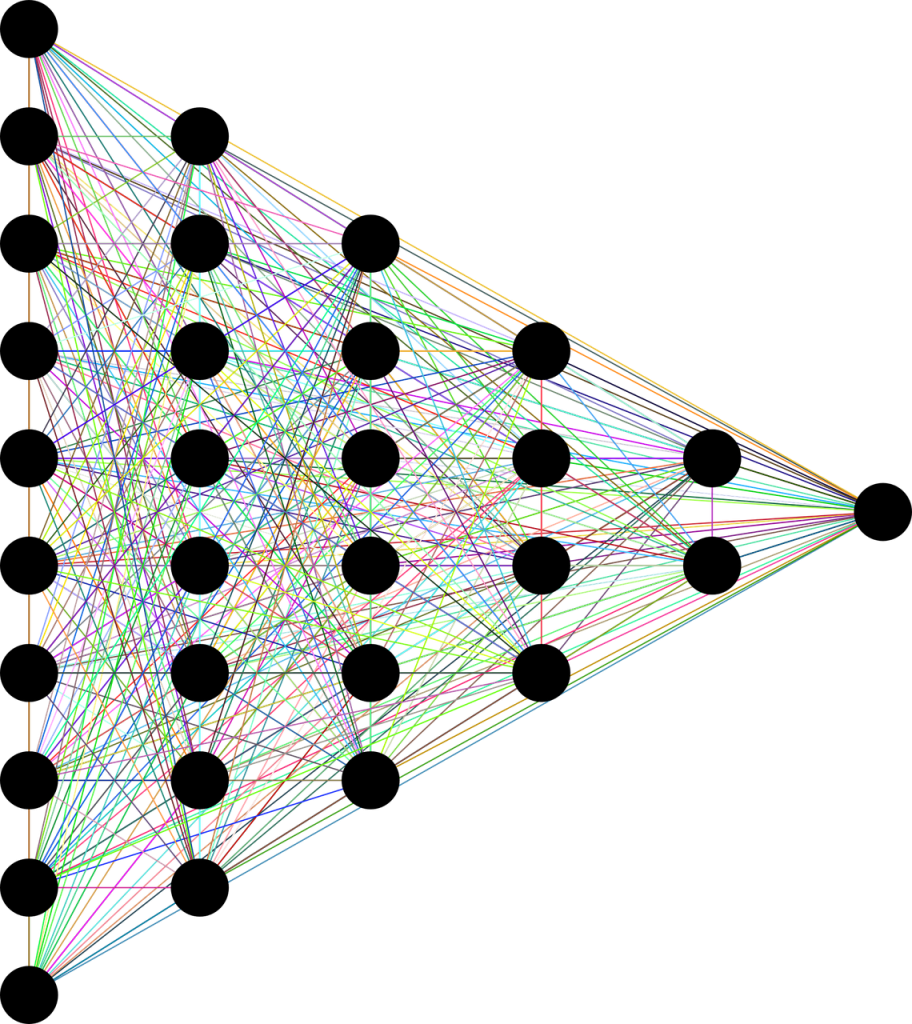So, let’s talk about the machine learning market for a moment. You might be wondering, is it saturated? Well, it’s a topic that has been widely debated among experts and enthusiasts. With the ever-increasing demand for intelligent technology, it’s no surprise that the machine learning market has experienced significant growth in recent years. But with so many players entering the arena, one can’t help but ponder if there’s enough room for everyone to thrive. In this article, we’ll explore the current state of the machine learning market and uncover whether saturation is a legitimate concern or just a passing worry.

This image is property of pixabay.com.
The Growth of the Machine Learning Market
Machine learning has experienced significant growth in recent years, revolutionizing industries and shaping the future of technology. With its ability to analyze vast amounts of data and make predictions or decisions based on patterns, machine learning has become a crucial component in various applications. In this article, we will explore the historical growth, current market size, and projected market growth of the machine learning market, as well as the factors influencing its saturation.
Historical growth
The machine learning market has seen remarkable expansion over the past decade. Advancements in computing power, the availability of large datasets, and breakthroughs in algorithms have propelled the growth of machine learning. The increasing demand for automation, predictive analytics, and personalized user experiences has driven businesses across industries to adopt machine learning technologies.
Current market size
As of now, the machine learning market is valued at billions of dollars and continues to grow exponentially. The increasing adoption of machine learning across sectors such as healthcare, finance, retail, and manufacturing has contributed to its current market size. Companies are leveraging machine learning to optimize business operations, enhance customer experiences, detect fraud, improve healthcare outcomes, and develop innovative products.
Projected market growth
The machine learning market shows no signs of slowing down. According to industry reports and market research, the market is projected to reach new heights in the coming years. Factors such as the proliferation of connected devices, advancements in natural language processing, and the potential for machine learning in emerging technologies like autonomous vehicles and robotics are expected to drive the market’s growth further.
Factors Influencing the Saturation of the Machine Learning Market
While the machine learning market continues to expand, there are several factors that could potentially lead to its saturation. It is essential to analyze these factors to understand the challenges and opportunities the market may face in the future.
Increasing competition
As the machine learning market grows, competition among technology companies intensifies. Established players and startups are constantly innovating and developing new machine learning tools, platforms, and applications. The increasing number of competitors entering the market may result in price wars, decreased profit margins, and the consolidation of smaller players.
Limited adoption in certain industries
Although machine learning has made significant inroads across various industries, there are sectors where its adoption is still limited. Industries with specific regulatory requirements, complex processes, or slow technology adoption may face challenges in implementing machine learning solutions. Overcoming these barriers and convincing industries of the benefits of machine learning will play a vital role in the future growth of the market.
Technical challenges
While machine learning has proven its potential, it is not without technical challenges. Developing accurate and reliable algorithms, managing and processing vast amounts of data, and ensuring the scalability of machine learning models are some of the technical hurdles that need to be addressed. Overcoming these challenges will be crucial to sustain the growth of the market and unlock its full potential.
Availability of talent
The demand for skilled professionals in the field of machine learning is skyrocketing. However, there is a significant shortage of talent with the expertise required to develop, deploy, and maintain machine learning systems. As the market expands, the availability of qualified individuals becomes increasingly scarce. Addressing the talent gap through education, training programs, and attracting talent from related domains will be crucial for the continued growth of the market.
Regulatory and ethical concerns
The rapid growth of machine learning raises important questions about ethics, privacy, and accountability. As machine learning algorithms make critical decisions in various domains, ensuring fairness, transparency, and accountability becomes paramount. Regulatory frameworks and ethical guidelines need to be established to address concerns such as algorithmic bias, data privacy, and the potential misuse of machine learning technology. Overcoming these concerns is essential for building trust and ensuring the long-term success of the machine learning market.

This image is property of pixabay.com.
Market Segmentation and Adoption
To understand the growth potential of the machine learning market, it is essential to analyze its segmentation and adoption across different domains.
Consumer applications
Machine learning has gained significant traction in consumer-facing applications. Virtual assistants, voice recognition systems, recommendation engines, and personalized advertising are just a few examples of how machine learning is enhancing consumer experiences. The convenience and personalization offered by these applications have contributed to their widespread adoption among consumers.
Enterprise applications
Enterprises are increasingly leveraging machine learning to streamline operations, automate processes, and gain valuable insights from data. Machine learning algorithms are being used in areas such as customer relationship management, supply chain management, fraud detection, and predictive maintenance. The potential for cost savings, increased efficiency, and improved decision-making is driving the adoption of machine learning in the enterprise sector.
Industry-specific applications
The machine learning market is also witnessing significant growth in industry-specific applications. Healthcare, finance, manufacturing, and retail are prime examples of industries where machine learning is reshaping processes, driving innovation, and improving outcomes. From medical image analysis to algorithmic trading, machine learning is enabling breakthroughs in these sectors, with potential applications that are yet to be fully realized.

This image is property of pixabay.com.
Opportunities for Growth in the Machine Learning Market
While the machine learning market continues to evolve, there are several opportunities that hold immense growth potential. These opportunities are likely to shape the future landscape of the machine learning market.
Emerging markets
The adoption of machine learning is not limited to developed economies. Emerging markets present significant growth opportunities due to factors such as increasing digitalization, rising smartphone penetration, and the need for technology-driven solutions. By catering to the unique needs and challenges of emerging markets, companies can tap into new customer bases and expand their presence.
Advancements in deep learning
Deep learning, a subfield of machine learning that focuses on artificial neural networks, has witnessed remarkable advancements in recent years. The ability of deep learning models to process unstructured data, such as images, videos, and natural language, has opened up new possibilities for machine learning applications. Advancements in deep learning algorithms and architectures are expected to propel the machine learning market forward and drive innovation in various domains.
Integration with other technologies
Machine learning is not an isolated technology; it thrives in synergy with other emerging technologies. Integration with technologies like cloud computing, edge computing, Internet of Things (IoT), and blockchain can unlock new use cases and create novel opportunities. By combining machine learning with these technologies, companies can develop intelligent, connected, and secure solutions that cater to evolving market demands.
Improvement in accessibility and affordability
As the machine learning market matures, there is a growing need for solutions that are accessible and affordable to a wider audience. Simplified machine learning tools, platforms, and pre-trained models enable non-experts to leverage the power of machine learning without extensive technical knowledge. Making machine learning more accessible and affordable democratizes its usage and opens doors for smaller companies and individuals to participate in the market.

Challenges in a Saturated Machine Learning Market
While there are numerous opportunities for growth, a saturated machine learning market presents challenges that need to be overcome for sustained success.
Diminishing value proposition
As the machine learning market becomes more crowded, differentiation becomes crucial. Companies must provide unique value propositions that set them apart from competitors. Innovations in algorithms, models, or specific industry applications can help companies maintain a competitive edge and continue to deliver value to customers.
Differentiation and specialization
To thrive in a saturated market, companies need to differentiate themselves through specialization. By focusing on specific industry verticals, niche markets, or unique use cases, companies can position themselves as experts in their respective domains. Specialization allows for deeper understanding, tailored solutions, and a competitive advantage that leads to long-term success.
Addressing bias and fairness
Machine learning algorithms are only as good as the data they are trained on. Bias in training data can lead to biased predictions and decisions, perpetuating societal inequalities. It is essential for companies to address bias and ensure fairness in machine learning models. Responsible data collection, diverse training datasets, and ongoing monitoring and auditing of algorithms are critical in mitigating bias and ensuring fairness.
Data privacy and security
Machine learning relies on vast amounts of data, which raises concerns about privacy and security. Companies must prioritize data privacy and implement robust security measures to protect sensitive user information. Building trust with users by being transparent about data usage and adhering to privacy regulations will be essential in navigating the challenges of a saturated machine learning market.
In conclusion, the machine learning market has experienced significant growth, but its future trajectory depends on various factors. While competition, limited adoption in certain industries, technical challenges, talent availability, and regulatory concerns may pose challenges, opportunities for growth in emerging markets, advancements in deep learning, integration with other technologies, and improved accessibility and affordability show promise. Overcoming challenges such as a diminishing value proposition, differentiation, addressing bias and fairness, and ensuring data privacy and security will be crucial for sustained success in a saturated machine learning market. By understanding these factors and embracing the opportunities and challenges ahead, companies can navigate the machine learning landscape and drive innovation in the future.

